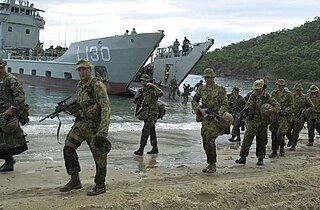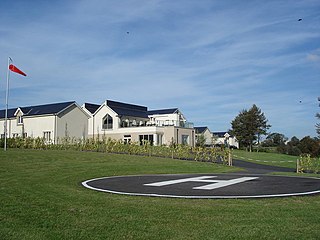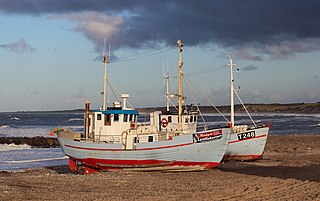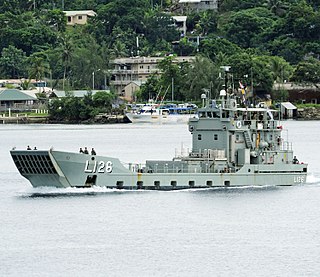
HMAS Barcoo (K375/F375/A245) was a River-class frigate of the Royal Australian Navy (RAN). One of twelve frigates constructed in Australia during World War II, Barcoo, was laid down by Cockatoo Docks and Engineering Company, Ltd. at the Cockatoo Island Dockyard in 1942, and commissioned into the RAN in early 1944.

HMPNGS Buna is a Balikpapan-class heavy landing craft operated by the Papua New Guinea Defence Force (PNGDF). Prior to 1974, the vessel was called HMAS Buna and was operated by the Royal Australian Navy (RAN).

HMPNGS Lakekamu is Balikpapan-class landing craft heavy (LCH) operated by the Maritime Operations Element of the Papua New Guinea Defence Force (PNGDF). The vessel was one of eight built for the Royal Australian Navy (RAN) in the 1970s, and was commissioned into the RAN as HMAS Labuan in March 1973. Labuan was decommissioned in November 2014. She was transferred to the PNGDF for use as a training ship and was commissioned as HMPNGS Lakekamu in December 2014.
HMPNGS Salamaua is a Balikpapan-class heavy landing craft operated by the Papua New Guinea Defence Force (PNGDF). Prior to 1974, the vessel was called HMAS Salamaua and was operated by the Royal Australian Navy (RAN).

Landing craft are small and medium seagoing watercraft such as boats, and barges, used to convey a landing force from the sea to the shore during an amphibious assault. The term excludes landing ships, which are larger. Production of landing craft peaked during World War II, with a significant number of different designs produced in large quantities by the United Kingdom and United States.

A dock landing ship is an amphibious warfare ship with a well dock to transport and launch landing craft and amphibious vehicles. Some ships with well decks, such as the Soviet Ivan Rogov class, also have bow doors to enable them to deliver vehicles directly onto a beach. Modern dock landing ships also operate helicopters.

The landing craft, tank was an amphibious assault craft for landing tanks on beachheads. They were initially developed by the British Royal Navy and later by the United States Navy during World War II in a series of versions. Initially known as the "tank landing craft" (TLC) by the British, they later adopted the U.S. nomenclature "landing craft, tank" (LCT). The United States continued to build LCTs post-war, and used them under different designations in the Korean and Vietnam Wars.

Landing Ship, Tank (LST), or tank landing ship, is the naval designation for ships first developed during World War II (1939-1945) to support amphibious operations by carrying tanks, vehicles, cargo, and landing troops directly onto shore with no docks or piers. This enabled amphibious assaults on almost any beach. The bow of the LST had a large door that would open with a ramp for unloading the vehicles. The LST had a special flat keel that allowed the ship to be beached and stay upright. The twin propellers and rudders had protection from grounding. The LSTs served across the globe during World War II including in the Pacific War and in the European theatre.

HMAS Tobruk was a Landing Ship Heavy (LSH) of the Royal Australian Navy (RAN), based on the design of the Round Table-class of the British Royal Fleet Auxiliary. Planning for the ship began in the 1970s to provide the Australian Army with a permanent sealift capability. She was laid down by Carrington Slipways in 1979, launched in 1980, and commissioned in 1981. She was a multi-purpose, roll-on/roll-off heavy lift ship capable of transporting soldiers, APCs, and tanks, and delivering them to shore via landing craft or directly by beaching.

HMAS Wewak was the fifth ship of the Balikpapan class of heavy landing craft operated by the Royal Australian Navy (RAN).

The Type 074 landing ship is a class of landing ship medium (LSM) of the People's Liberation Army Navy. They were built at Wuhu Shipyard of Wuhu, Anhui from 1995 to 2000. Although entering service in the mid-1990s, the origin of Type 074 dates to almost three decades earlier in the mid-1960s, and Type 074 is the result of experience learned from around half a dozen models earlier.

The Royal Australian Navy and Australian Army have operated 24 amphibious warfare ships. These ships have been used to transport Army units and supplies during exercises and operational deployments.
The Australian landing ship medium Brudenell White was a United States Navy landing ship medium which was later sold to Australia and operated by the Australian Army.

The Mark 8 Landing Craft Tank were landing craft tank ships operated by the British Armed Forces. The vessels were based on an American design, but improved into ocean-going vessels capable of transiting to and operating in the Far East.
The Australian landing ship medium Clive Steele was a United States Navy landing ship medium which was later sold to Australia and operated by the Australian Army.
The Type 271 landing craft is a family landing craft of the People's Liberation Army Navy (PLAN). Most models in this class are landing craft utility (LCU)s, but the last model has been developed into a Landing ship medium (LSM).

BRP Ivatan (AT-298) is a Balikpapan-class heavy landing craft operated by the Philippine Navy. One of eight vessels built by Walkers Limited for the Royal Australian Navy (RAN), the ship was commissioned into Australian service in 1973 as HMAS Brunei. During her RAN career, Brunei visited Lord Howe Island, was deployed post-Cyclone Tracy as part of Operation Navy Help Darwin, performed coastal surveys of northern Australia and Papua New Guinea, and served as part of the INTERFET peacekeeping taskforce.

BRP Batak (AT-299) is a Balikpapan-class heavy landing craft operated by the Philippine Navy. One of eight vessels built by Walkers Limited for the Royal Australian Navy (RAN), the ship was commissioned into Australian service in 1973 as HMAS Tarakan. During her RAN career, Tarakan was deployed post-Cyclone Tracy as part of Operation Navy Help Darwin, undertook various surveying operations, was placed in reserve between 1985 and 1988, relocated an overpopulation of Tridacna gigas clams, was part of the INTERFET peacekeeping taskforce, and participated in a Pacific Partnership humanitarian deployment.






















